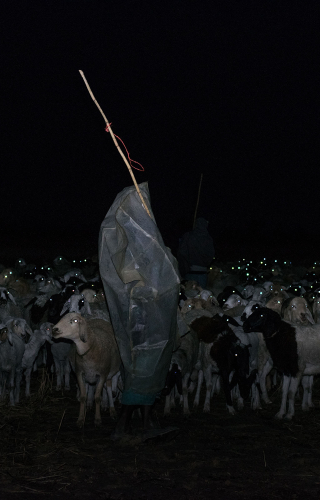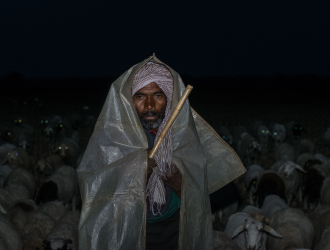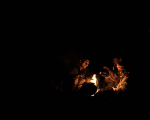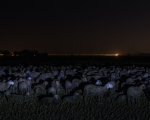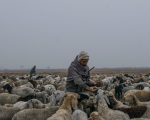December 2018. I am somewhere in the vast fields of Rarh (region between the Chhota Nagpur Plateau to the west and Ganges River to the east). The sun has set hours back and the air hangs heavy with evening mist. On the distant highway, a transportation truck cuts a streak of light through the dark horizon. Alone, wrapped in a kambal (blanket) and armed with a lathi (walking/herding stick), Mahesh Pal patrols his flock in the chilly darkness. He is silently watched over by Boötes (a constellation in the northern sky, which means herdsman) from the heavens above. The flock huddle tighter to retain the body heat within. The young lambs bleat in fear, as a distant fox yowls. Mahesh must keep the foxes away, but the greater threat to his flock are not wild animals, but human poachers.
In 2016, I had come across a group of people moving with large flocks of sheep in the open land around my village Barah, in Birbhum district of West Bengal. Instinctively, I took a few photographs. Later, spurred by curiosity, I wanted to learn more about them. After a year-long wait, I met Mahesh Pal when they were back in our village on their yearly peregrination.
Mahesh told me he is a meshpal (shepherd) from the Gadariya pastoralist community. Their name is derived from the old Hindi word gadar, meaning sheep. These Gadariyas migrate seasonally and follow routes which their ancestors have traversed for centuries. Unlike other nomadic pastoralists who migrate with their families from one place to another, among the Gadariyas only the abled body men migrate with their livestock, while their families lead domestic lives in villages, engaged in agriculture or other jobs. They speak the Magahi dialect of Hindi. They wear simple clothes, a lungi and a cloth tied around their head. They are most easily recognised by their multipurpose bamboo stick and Bajrangbali (Hanuman) lockets, which they wear as a protective talisman.
The Gadariyas are spread across several states in India and are known by different names in different regions. In Maharashtra they are known as Dhangar, in Rajasthan as Gairi, and in Madhya Pradesh and Uttar Pradesh as Baghel. In Bihar they are mostly settled in Gaya, Bhagalpur, Banka, Jamui, Munger and Jehanabad districts. In December, when the reaping of the rice crop is complete, they migrate to West Bengal, crisscrossing mainly Murshidabad, Bardhaman and Birbhum districts. The alluvial plains of the Rarh region have always been heavily cultivated. Over generations, the meshpals have established a transactional relationship with agriculturalists in the Rarh region. They visit the landowners at their residence to strike a deal—the meshpals are paid in cash or kind (or a combination of both) to graze and halt their sheep-herd on their lands for a certain number of nights. This donation is used as food ration or to buy provisions during their wanderings. In return, the excreta of the sheep act as organic fertilizer for the soil before the next course of cultivation. This arrangement works particularly well in the Rarh region as it is comparatively drier than the rest of West Bengal, hence the fields remain barren, except for stubble, for a few months between crops. After grazing on the stubble for months, in April-May, when the land is being prepared for the sowing of paddy, these people gradually move towards the highlands of the Chhota Nagpur Plateau.
‘Lord Krishna was a shepherd like us. We, the people of the Pal community, have a special relationship with Krishna. You will find Yadav, Pal, Ghosh and Bhagat among us. All of them are of the same social status,’ Sudhir states while kneading khaini (chewing tobacco) on his palm. Gorilal, another herdsman in his early thirties, tells me he wanted to be a mason. ‘Do you know why I am ruining my life in this profession? My parents had to raise a large family; my four brothers and three sisters. Looking for work, I had to drop from school in the eighth standard. If I could pursue a bachelor’s degree, I could privately tutor 20–25 pupils at least and earn four thousand rupees per month. As long as my parents are alive, I will have to pasture this flock. They get sentimental about it. Baba had spent his whole life herding sheep. He has even threatened to poison himself to death if I abandon this profession. But when they are dead, these sheep will be finished.’
The Gadariyas rear sheep, and make a living by selling livestock as well as the wool harvested from them thrice a year. The ewes produce offspring throughout the year, consistently adding numbers to the flock. Every 3–4 months, they stabilise population by culling the extra counts. These are sold to middlemen called paikars, who in turn sell them in village haats (markets). The paikars determine the final price only after thoroughly examining the health of each and every sheep. The sheep sold in haats are mostly bought by slaughterhouses. Some of them, mostly lambs, are bought by domestic households where they are raised and sold at a profit later.
Though I had travelled with these meshpals through the different parts of Birbhum and Bardhaman, I also wanted to meet their families in Bihar. But when I expressed my wish, they became suspicious of my intentions. After months of persuasion, I gained Niranjan’s trust. We took a train from Bolpur station till Sultanganj, in Bhagalpur district. The train was late by four hours but Niranjan never seemed anxious. His life seemed to be unrestricted from the confines of all deadlines. I guess, if you live immersed in the vastness of the fields and the sky for months on end, the construct of punctual time diminishes. From Sultanganj, I accompanied him on a 11-kilometre walk through picturesque wheat fields and reached Charhaiya, his native village. At Charhaiya, Niranjan owns a small cultivable land and a single-room hut to accommodate his family of nine. Though they do some farming, there is little or no significant income from the small plot of land they own. The wheat and vegetables grown there are solely used for family sustenance. However, in local culture, owning land is a matter of social prestige, and oftentimes these plots are not inherited but bought from the money saved in pastoralism. Notwithstanding their limited economic resources, they packed hot parathas (with pickle) for my solo return journey the same evening.
Historically, other than sheep rearing, Gadariyas made kambals from the wool harvested. To meet a community of kambal makers, I visited Patuli, located in Bardhaman district. Approximately two hundred families of the Bhagat community reside there, who weave woollen blankets as their primary occupation. There I met old Durga Bhagat, who was at the time, a hundred years old. She reminisced about the past, ‘Every man from this community used to graze and weave. My maternal family was the exception. They served in the treasury of the local zamindar. My husband used to pasture his flock in distant Kal (Utkal, modern Odisha) and Rarh province, and used to be away for four-month stretches. During his long absence, I never missed him or got upset.’ The ancestors of these weavers were pastoralists once but have now forsaken their semi-nomadic way of life, though they still intermarry with pastoralists.
Aware of their social restraints caused by lack of education, these Gadariyas, today understand the need for sending their children to school. On their great migrations, the fathers do not bring along their male children like before, leaving them at home to study. Education is like a double-edged sword for any pastoral community. Durga Bhagat’s son, Sadhan Bhagat, gave me a reality check, ‘Nobody maintains a flock anymore. The youngsters have decided to do office jobs. The shepherds have to endure exposure to extreme weather all year round. If there is a storm or a cloudburst, nobody is going to help you in the open fields. Sometimes, it seems military jobs are far better than being a shepherd.’ Unsurprisingly, those youths who have received even the most rudimentary education seek employment elsewhere, and sooner or later abandon the itinerant lifestyle of their forefathers.
In addition to a combination of various socio-economic reasons, the shepherds are also facing the loss of pastoral lands. In order to provide food to a rapidly growing urban population, the British colonial administration of this region had put maximum arable land under cultivation, even encroaching on fallow lands traditionally used for grazing. This trend has continued post-Independence with increasing encroachment on forest cover, open fields, wetlands and grasslands. Also, unlike pastoralists who rear bovine, the sheep-raising Gadariyas do not harvest milk or any dairy products. Wool is the only raw material (other than meat, but goat meat is far more in demand than sheep meat) they can sell around the year. With winters getting warmer in northern India, there has been a drop in wool demand, further cutting into their livelihood. Will these factors push them out of their transhumance way of living which they have engaged in for millennia? With each winter sundown, I yearn to see Mahesh Pal return with a thousand sheep hoofing dust through the fields of my village. But I also fear that one winter they will not return anymore.
